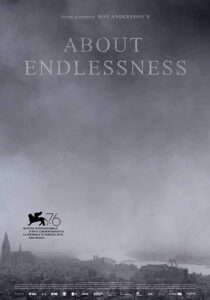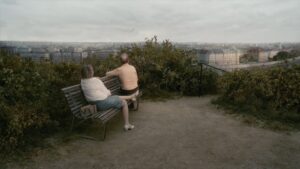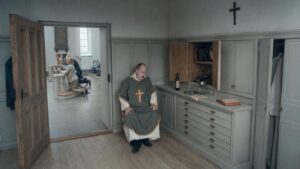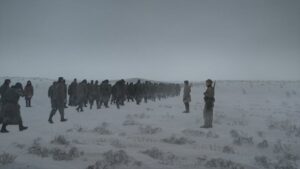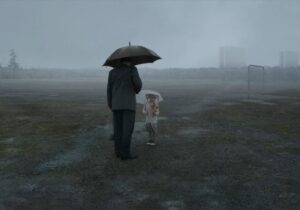Written and Directed by Roy Andersson | 78 min | Carbon Arc Cinema
Before watching About Endlessness I knew about the work of this Swedish auteur mostly by his festival features like Songs From The Second Floor and A Pigeon Sat On A Branch Reflecting on Existence, films that never got theatrical distribution here and have been hard to find otherwise. This is reportedly his final offering — as he nears 80 he’s calling it a day. About Endlessness will almost certainly be one of the most thoughtful and peculiar cinematic experiences any cineaste is liable to have this year.
Andersson’s film muses on human experience, from the ordinary and mundane to the spiritual and profound. He’s clearly not influenced by many other filmmakers. Rather, you can see a history of painting in the visuals of his work, artists like Pieter Bruegel, Andrew Wyeth, and Edward Hopper, in the diffuse light, the lack of shadow, the viewer at a middle distance, and the tableau vivant.
The character blocking, if you can call it that, welcomes the viewer to look at the whole image not just the performers in it. His sets are frequently created using models and green screen, and he casts actors who tend to look like average human beings, putting them in a lot of theatrical make-up. The men are heavy, middle-aged, and frequently balding.
About Endlessness is a collection of individual scenes, most unconnected. People have conversations, meet up, depart, ask questions, live, die, and murder. Three women spontaneously dance outside a cafe to a song on the loudspeakers and receive applause from the diners. A girl and her father are off to a birthday party but get caught in the rain. A woman gets off a train and waits on the platform. A defeated army marches through the ice and snow to a Siberian prison camp. Hitler realizes his plans have come to naught. Almost all these vignettes are introduced, or accompanied by, a voiceover providing a brief bit of context. Like a particularly opaque New Yorker cartoon, you sometimes struggle to parse the deeper significance of the individual scene, but taken as a whole the impact is undeniable.
I noticed a couple of narratives connecting a few of the individual scenes: A priest loses his faith and complains to his therapist, but gets no guidance. He shows up at the therapist’s office when he doesn’t have an appointment and is ushered out into the hall. And a man tells a story to the camera of having seen someone he knew from school who ignores him because of bad blood. We see the same man again later on, reporting on another sighting of his frenemy as his wife wonders why he’s so bothered by it.
There’s no doubt of Andersson’s wry, sometimes absurd sense of humour — it’s the sugar to make a lot of this pensive, episodic storytelling an easier swallow. If you’re not tuned into his particular wavelength, this all might seem like a bit of a Kafkaesque challenge, but at this very modest length, it serves as a great introduction (and capper) to his work.
I haven’t been able to stop thinking about it since I watched it — the cumulative effect of this series of stories, like a group of whimsical anecdotes, sinks into the subconscious. I now have an urge to visit more of his work.






